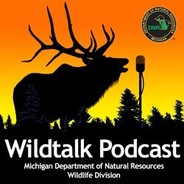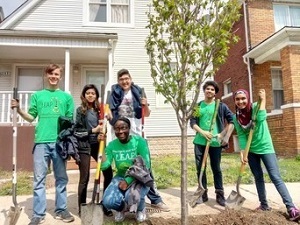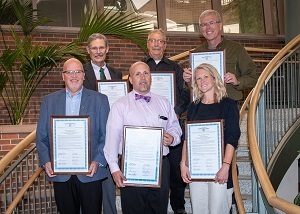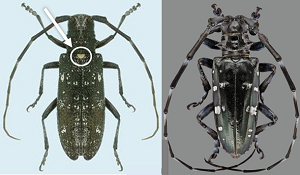|
Here's a look at some of this week's stories from the Department of Natural Resources:
See other news releases, Showcasing the DNR stories, photos and other resources at michigan.gov/dnrpressroom.
 On the DNR's Wildtalk podcast, wildlife staff chew the fat and shoot the scat about all things habitat, feathers and fur. With insights, interviews and listener questions answered on the air, you'll come away with a better picture of what's happening in the world of Michigan wildlife.
In episode #3, find out more about the DNR's Hunting Access Program, which helps people find land to hunt throughout the state. Later in the show, learn what you should do if you discover a raccoon in your attic!
Questions about something you heard on the podcast? Contact the DNR Wildlife Division at 517-284-WILD (9453).
|
 With the start of the school year fast approaching for many, don’t forget to include Michigan’s wildlife in your class plans.
The DNR offers a variety of wildlife classroom curricula at the elementary, junior high and high school levels, and each program is developed to fit current state educational standards. Better yet, they're free to educators! Topics include:
-
Elk University. One hundred years ago, wild elk were brought to Michigan to re-establish the state’s elk population. High school students are put in the role of wildlife managers, while learning about this conservation success story through Elk University. These lessons also include Michigan history, forest management and social considerations for wildlife management.
-
A Year in the Life of a Michigan Black Bear. Sixth-, seventh- and eighth-grade students have the chance to learn all about black bears in Michigan – from their life history to how the DNR manages populations – in this curriculum. Students also get to “follow” black bear movements in Michigan by looking at actual location data from collared bears.
-
Wondrous Wetlands and Waterfowl. Middle schoolers can get an introduction to wetland habitats with this program. These lessons have activities about wetlands and the ducks, geese and swans that live in Michigan, and give students an opportunity to look at how different land uses affect wildlife habitats, including wetlands.
-
Go Wild for Michigan’s Wildlife. This curriculum introduces elementary-age students to a variety of species found throughout Michigan and their supporting habitats. Materials include sets of Critter Cards for each student to keep; however, those sets are limited and are issued on a first-come, first-served basis to Michigan educators who register. All registered educators will receive an electronic copy of the Critter Cards to use.
For more information, including how to register, visit michigan.gov/dnreducation or contact Hannah Schauer at 517-388-9678.
|
 Thirty-six communities and organizations across Michigan recently learned they’re getting a share of $80,518 to support their tree-planting efforts. The grants, from the DNR, the DTE Energy Foundation and ReLeaf Michigan, will support the planting of 1,600 trees along streets and in parks and other public spaces.
"Trees help to make our communities and neighborhoods beautiful, healthy and vibrant places,” said Kevin Sayers, DNR Urban and Community Forestry program coordinator. “This program promotes properly locating and planting trees to ensure they stay healthy for years to come.” The grants will support the purchase of a variety of trees to be planted this fall or next spring.
The program is part of a long-term DTE Energy Foundation/DNR initiative to partner with communities, schools and nonprofits to take care of the environment. Since the program’s founding, nearly 40,000 trees and seedlings have been planted in 500-plus communities. The program, funded by the DTE Energy Foundation, is administered through a collaborative partnership between the DNR and the nonprofit ReLeaf Michigan to increase opportunities for community involvement statewide.
“The DTE Energy Foundation is committed to supporting nonprofit organizations focused on protecting Michigan’s natural resources,” said Lynette Dowler, DTE Energy Foundation president.
“Our 22-year partnership with the DNR and, more recently ReLeaf Michigan, has helped more than 500 communities across the state become both more beautiful and more environmentally friendly,” she said. “This is a legacy of which we can all be proud.”
Communities interested in launching volunteer tree plantings or educational events are encouraged to contact ReLeaf Michigan at 800-642-7353 or visit releafmichigan.org.
For more on the DTE Energy Foundation and its programs, contact Anne O’Dell 313-235-5555.
For a list of approved grants or information on the Urban and Community Forestry program, contact Kevin Sayers at 517-284-5898 or visit michigan.gov/ucf.
|
 Chronic wasting disease is a fatal neurological disease that has been confirmed in free-ranging white-tailed deer in six Michigan counties since the first confirmed positive in 2015. Last fall, the DNR and Natural Resources Commission created the CWD Working Group and challenged its members to identify more actions to substantially mitigate CWD in Michigan.
The group's members (representing agriculture, sportsmen, conservation and other related areas) talked with hunters, residents and others around the state, looked at research, and spent time developing several recommendations centered around communication, research funding, biosecurity and regional cooperation and management.
Much of that work helped inform new regulations for the 2018 deer hunting season, which were approved last week at the Natural Resources Commission meeting. Several CWD Working Group members also were recognized for their efforts in a presentation at that meeting.
Learn more about chronic wasting disease at michigan.gov/cwd.
|
 Michiganders looking to learn a new outdoor pursuit, or get better at one, have a unique opportunity with the DNR’s Outdoor Skills Academy.
The Outdoor Skills Academy brings expert instructors to locations around the state for classes on a range of outdoor activities. Upcoming examples include an award-winning nature photographer who will teach a workshop on photographing birds and a collegiate coach and Olympic instructor who will lead an archery class.
“Outdoor Skills Academy classes are unique in that they explore these topics in-depth – for a full day or more, with knowledgeable and skilled instructors leading the way – at an affordable cost,” said Jon Spieles, DNR field manager for educational services.
Tom Haxby, a nature and wildlife photographer from Kingsley, Michigan, will teach a photographing birds workshop Aug. 18-19 at P.J. Hoffmaster State Park in Muskegon. Haxby’s photographs (like the one above) have been chosen among the top 250 photos by the North American Nature Photography Association, among other awards, and have been published in numerous books, magazine covers and articles, and calendars.
The class will cover effective use of photography equipment and techniques and will include time in the park to practice skills.
Becoming an Expert Archer, a class coming to Ludington State Park Sept. 15, will feature instructor Nick Di Cresce, a professional archer, Wayne State University’s head archery coach and USA Olympic instructor.
Di Cresce will teach participants about the safe and correct way to shoot a bow and arrow and the various kinds of archery equipment. Participants will shoot at targets throughout the class and will finish the day with a competition for prizes.
For more information, visit michigan.gov/outdoorskills or contact Elizabeth Tillman at 231-798-3573 (bird photography workshop) or Alan Wernette at 231-843-9261(archery class).
|
 The Asian longhorned beetle is a highly destructive, invasive pest that can kill maple, birch, elm, willow and other hardwood trees. Since August is national Tree Check Month, people are encouraged to keep an eye out for this invader that is known to be in Ohio, New York, Massachusetts and Ontario. Reporting sightings or signs of this pest can help prevent widespread tree loss in Michigan.
A native of China and Korea, the Asian longhorned beetle (Anoplophora glabripennis) is considered an invasive species in the United States. Adult beetles have bullet-shaped bodies from 3/4 inch to 1-1/2 inches long. This beetle is shiny black with white spots and long, black-and-white-striped antennae. Its legs and feet may be bluish in color.
A similar beetle native to Michigan is often mistaken for the Asian longhorned beetle.
The white spotted pine sawyer (Monochamus scutellatus) has a distinctive white spot below the base of its head – between the tops of its wing covers. This, and it being brown or dull black in color, distinguishes the sawyer from the Asian longhorned beetle.
Anyone who sees Asian longhorned beetle or its signs or symptoms is asked to report it. If you can capture the insect, look to see if it has a spot between the top of its wing covers – if so, it likely is a white spotted pine sawyer. If not, place the insect in a jar and freeze it. Take photos, note the location and report it as soon as possible by email to the Michigan Department of Agriculture and Rural Development at MDA-info@michigan.gov, by phone to 800-292-3939 or online to the Midwest Invasive Species Information Network at misin.msu.edu.
Get more details on the Michigan Invasive Species website’s Asian longhorned beetle page, michigan.gov/alb.
|
PHOTOS AVAILABLE: High-res versions of some of the photos above, as well as others related to the stories, are available in this photo folder.
|